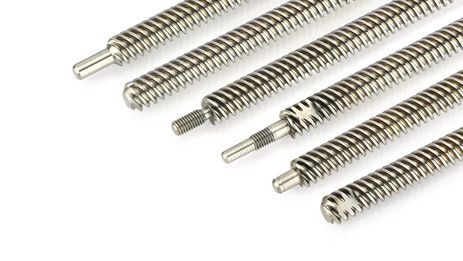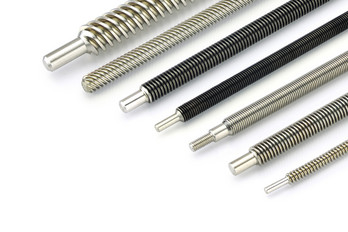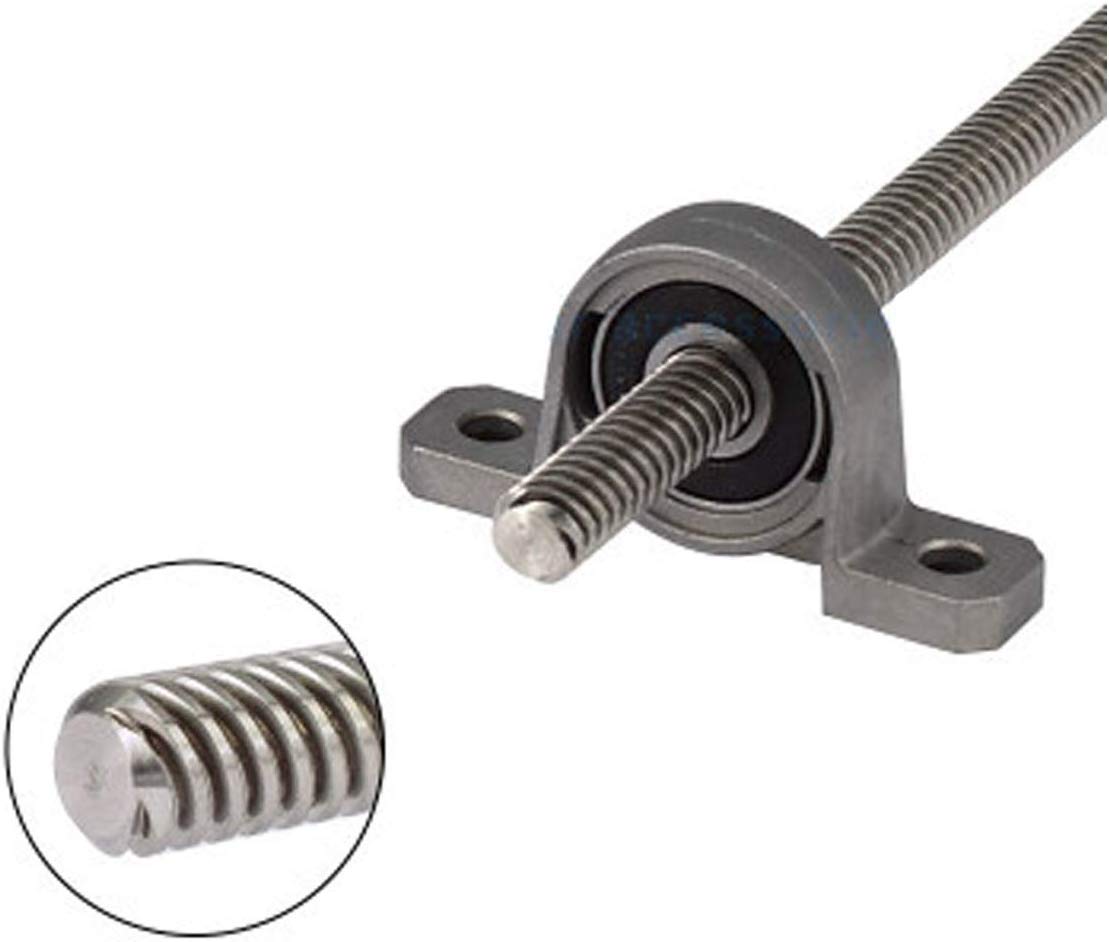Product Description
stainless steel reciprocating lead / reciprocating screw
Product Description
1. Cold rolled ball screw;
2. Gcr15 material;
3. High-speed operation
4. C5 C7 C10 precision;
5. No gap and preloading
6. Quality as good as TBI brand is high precision, long life use.
7. Pay more attention to before-sale, in-sale, after -sales service.
8. Manufacturer with large stock & short delivery
1.We can offer OEM ODM SERVICE accoding your drawing.
2.we can accoding u drawing do the ball screw end
3. We can design custom ball screw,according to customer’s requirement
4.We can supply the ball screw auxiliary product ,servo motor, ball screw support nuit, nut housing, coupling and so on
Product Parameters
| Reciprocating screw specifications | |||
| Diameter(mm) | Lead(mm)/pitch | Effective stoke(mm) | Total length(mm) |
| 10 | 10 | 50 | 130 |
| 10 | 10 | 80 | 200 |
| 10 | 10 | 100 | 200 |
| 10 | 10 | 120 | 150 |
| 10 | 10 | 150 | 250 |
| 10 | 10 | 200 | 300 |
| 20 | 20 | 150 | 400 |
| 20 | 20 | 200 | 430 |
| 20 | 20 | 220 | 430 |
| 20 | 20 | 250 | 460 |
| 25 | 25 | 300 | 460 |
| 25 | 25 | 350 | 600 |
| 25 | 25 | 400 | 600 |
| 25 | 25 | 500 | 700 |
| Can be customized | |||
Detailed Photos
Factory Tour
Certifications
Company Profile
Contact us
/* January 22, 2571 19:08:37 */!function(){function s(e,r){var a,o={};try{e&&e.split(“,”).forEach(function(e,t){e&&(a=e.match(/(.*?):(.*)$/))&&1
| Material: | Carbon Steel |
|---|---|
| Axis Shape: | Straight Shaft |
| Shaft Shape: | Stepped Shaft |
| Appearance Shape: | Round |
| Transport Package: | Wooden Case |
| Specification: | can be customized |
| Customization: |
Available
|
|
|---|

How do lead screws contribute to the efficiency and accuracy of linear motion systems?
Lead screws play a crucial role in enhancing the efficiency and accuracy of linear motion systems. Here’s how they contribute to these aspects:
Efficiency:
Lead screws can contribute to the efficiency of linear motion systems in the following ways:
- Mechanical Efficiency: Lead screws can achieve high mechanical efficiency in converting rotary motion into linear motion. The efficiency depends on factors such as the thread design, lubrication, and preload. When properly designed and lubricated, lead screws can operate with minimal friction and energy loss, ensuring efficient power transmission. This efficiency allows for effective utilization of the input power and reduces energy consumption.
- Self-Locking Capability: Lead screws have a self-locking characteristic, which means they can hold their position without the need for additional locking mechanisms. The friction between the mating threads helps prevent back-driving and maintains the position of the load. This self-locking property eliminates the need for continuous power input to hold the position, improving overall efficiency.
- No Energy Consumption at Rest: When the lead screw is not in motion, it does not consume any energy. This is advantageous in applications where the load needs to be held in position for extended periods. The self-locking feature of lead screws ensures that the load remains stationary without energy input, contributing to energy efficiency.
Accuracy:
Lead screws contribute to the accuracy of linear motion systems in the following ways:
- Precise Positioning: Lead screws allow for precise positioning of components or loads. The thread pitch and design, combined with the rotational input, enable accurate and controlled linear movement. This precision is crucial in applications that require accurate alignment, spacing, or adjustment of components.
- Repeatability: Lead screws provide excellent repeatability in linear motion. Once a position is established, lead screws can reliably return to the same position repeatedly. This repeatability is critical in applications where consistent and repeatable motion is required, such as in CNC machines or automated systems.
- Low Backlash: Backlash refers to the axial movement or play between the screw and nut when changing direction. Lead screws can be designed to minimize backlash, resulting in more accurate positioning and reduced lost motion. Low backlash is particularly important in applications that demand precise positioning, such as machining operations or optical systems.
- Elimination of Drift: Lead screws help eliminate drift or movement over time. Once a position is set, the self-locking property of lead screws ensures that the load remains stationary without any gradual drift or positional changes. This stability is beneficial in applications where maintaining a fixed position is critical, such as in inspection systems or medical equipment.
Overall, lead screws provide efficient power transmission, self-locking capability, precise positioning, repeatability, and low backlash, all of which contribute to the efficiency and accuracy of linear motion systems. These characteristics make lead screws suitable for a wide range of applications where controlled and reliable linear motion is required.

How do electronic or computer-controlled components integrate with lead screws in modern applications?
In modern applications, electronic or computer-controlled components play a crucial role in integrating with lead screws to enhance functionality, precision, and automation. These components enable advanced control, monitoring, and feedback capabilities, allowing for more efficient and accurate operation of systems incorporating lead screws. Here are some ways electronic or computer-controlled components integrate with lead screws in modern applications:
- Position Control: Electronic control systems can precisely control the position of the lead screw by monitoring and adjusting the rotational movement of the motor driving the screw. Position feedback sensors, such as encoders or linear scales, provide real-time information about the screw’s position, allowing the control system to accurately position the load. This integration enables precise positioning and highly repeatable motion control in applications such as CNC machinery, 3D printers, or robotic systems.
- Speed and Velocity Control: Electronic control systems can regulate the speed and velocity of the lead screw by controlling the motor’s rotational speed. By adjusting the motor speed, the control system can achieve specific linear speeds or velocity profiles along the length of the lead screw. This integration is particularly useful in applications where controlled acceleration, deceleration, or dynamic speed changes are required, such as automated manufacturing processes or motion control systems.
- Force and Torque Control: In some applications, it is necessary to control the force or torque applied by the lead screw. Electronic control systems can monitor and adjust the motor’s current or voltage to regulate the applied force or torque. This integration allows for precise force control, load balancing, or torque limiting in applications such as material testing machines, automated assembly systems, or lifting mechanisms.
- Automation and Synchronization: Electronic or computer-controlled components facilitate the automation and synchronization of multiple lead screws or other mechanical components. Through centralized control, these components can coordinate the movements of multiple lead screws, ensuring precise and synchronized motion. This integration is commonly used in complex systems with multiple axes of motion, such as multi-axis CNC machines or robotic systems.
- Monitoring and Diagnostics: Electronic control systems can monitor the operating parameters of lead screws, such as temperature, vibration, or load conditions. By integrating sensors and monitoring algorithms, the control system can detect abnormal conditions, provide real-time feedback, and trigger appropriate actions, such as alerting maintenance personnel or implementing protective measures. This integration enhances system reliability, prevents failures, and enables predictive maintenance in applications where lead screw performance is critical.
- Human-Machine Interface (HMI): Electronic or computer-controlled components often provide a user interface through which operators can interact with the lead screw system. HMIs allow operators to input commands, monitor system status, and receive feedback. This integration simplifies system operation, enables parameter adjustments, and facilitates troubleshooting or diagnostics.
In summary, electronic or computer-controlled components play a vital role in integrating with lead screws in modern applications. Position control, speed and velocity control, force and torque control, automation and synchronization, monitoring and diagnostics, and human-machine interface capabilities enhance the functionality, precision, and automation of systems incorporating lead screws. This integration enables advanced control, improved performance, and enhanced operational capabilities in various industries and applications.

How does a lead screw differ from other types of screws in terms of design and functionality?
A lead screw differs from other types of screws in terms of its design and functionality. Here’s a detailed explanation of the distinctions between lead screws and other screw types:
- Thread Design: Lead screws have a helical thread design, meaning the threads wrap around the screw’s cylindrical shaft in a continuous spiral. This helical thread allows for the conversion of rotary motion into linear motion. In contrast, other types of screws, such as machine screws or wood screws, typically have a straight or tapered thread design suited for fastening or joining applications.
- Linear Motion Conversion: The primary function of a lead screw is to convert rotary motion into linear motion or vice versa. It achieves this by utilizing the engagement between the helical threads on the screw and the matching threads on the nut. This capability makes lead screws suitable for applications requiring precise positioning, actuation, or adjustment of components along a linear path. In contrast, other screws are primarily used for fastening, joining, or securing objects together.
- Precision and Control: Lead screws offer precise control over linear movement due to their thread pitch and the ability to rotate the screw with precision. The pitch determines the linear distance the nut will travel for each revolution of the screw. This feature makes lead screws well-suited for applications that demand accurate positioning or adjustment. In contrast, other screws are not designed with the same level of precision or control over linear motion.
- Load Handling: Lead screws are designed to handle both axial loads (tension or compression forces) and torque. The helical threads and the engagement between the screw and nut distribute the load over a larger surface area, allowing lead screws to support and transfer significant loads. Other screw types, such as machine screws or wood screws, are primarily used for fastening and may not have the same load-bearing capabilities as lead screws.
- Applications: Lead screws find applications in various mechanical systems that require precise linear motion, such as CNC machines, 3D printers, robotic systems, and adjustable mechanisms. They are commonly used for positioning, actuation, or adjustment purposes. Conversely, other types of screws serve different purposes, such as machine screws used for fastening components together, wood screws for joining wooden materials, or self-tapping screws for creating threads in materials like metal or plastic.
Overall, the key differences between lead screws and other types of screws lie in their thread design, their ability to convert rotary motion to linear motion, the precision and control they offer, their load-handling capabilities, and the specific applications they are designed for. Understanding these distinctions is essential when selecting the appropriate screw type for a particular mechanical application.


editor by CX 2024-03-02